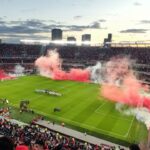


“Milito hay uno solo, Milito hay un solo,” sang the crowd of more than sixty-four thousand at Estadio Domingo Peron, the football stadium known by locals and fanaticos (fans) as ‘El Cilindro’ (The Cylinder) in the municipality of Avellaneda, just south of the Mantanza River from the more famous La Bombonera, home of Boca Juniors. They were singing for the home town hero, Diego Milito, the star striker wearing the number 22 jersey.
Undoubtedly, the most sought after football tickets in Buenos Aires are for the games of Boca Juniors or their rivals River Plate, the most valued tickets being for the Superclasico match between these two Latin American football giants. The Superclasico is the Argentine equivalent of famed European rivalries such as Barcelona vs Real Madrid or Arsenal vs Manchester United. Chat with any Argentinean and invariably this question will arise: “Are you for River or Boca?”
Visitors and newly arrived ex-pats, on being asked this questions at many social gatherings, may not be aware that other Argentine clubs also command the die-hard idolatry of millions of fans. The fantastically named Racing Club de Avellaneda is one such club. It is considered among the top five teams in Argentina’s first division football league, nicknamed ‘La Academia’ or The Academy due to its impressive record of having won the national cup 12 times and the first division league title 17 times.
I traveled to the city of Avellaneda with two friends, who were both lifelong Racing fans. They had invited me to this game against relative minnows Club Atlético Temperley, due to its importance to one particular player – it would be the final game of hometown hero, Diego Milito, a player who began his career with Racing before going on to make his reputation in European football (winning the EUFA Championship 2010 with Inter Milan) and representing the national side in two World Cups and winning two Copa America tournaments. He returned to Racing in 2014 to end his storied career. That year, Racing Club won its first league title in over 13 years.
It was expected to be sold-out crowd and the atmosphere emotional. On the short walk from the parking garage down the main street towards the stadium, the streets were filled with fanaticos of several generations; grandparents, parents, young couples, teenagers and children. There were pre-game parties happening at every corner cafe or on the side streets near the stadium. Vendors on the street sold jerseys, scarves and knitted caps, or touting cold beers (alcohol is not sold within the stadium). It was a carnival atmosphere.
But it was not all a fiesta. In all the merriment, I witnessed some elements of the underworld of the barra bravas that caused me to be on guard. The barra bravas are fanatical clubs of supporters who have been linked to the illegal scalping of tickets, the drug trade and other illicit activities. They operate more or less in the open as local police are allegedly paid off to look the other way. Even my two companions, experienced Racing fans, were cautious. I saw a man tuck a bowie knife down the back of his pants as he sauntered leisurely across six lanes of busy traffic to converse with his associates selling street side beers and knock-off jerseys. Shifty-eyed strangers would sidle up to you offering tickets.
Near the stadium, the heavy police presence became noticeable. Mounted officers with shotguns slung from their shoulders. Riot police in paramilitary uniform, holding three-foot long nightsticks and heavy plastic shields. Despite all this, no one was on edge. It was completely normal, part of the pre-game atmosphere at any big game in Buenos Aires. Outside the stadium, there are long lines of people at ticket counters either buying last minute tickets or collecting pre-sales.
Suddenly, a fist fight broke out between two large men. They squared up to another, fists cocked like brawlers in a shipyard. The two men landed punches on another, were then broken up by others, who in turn were drawn into a fight. Not fifteen feet away, a line of riot police guarding an entry to the stadium simply watched, bemused. It lasted no more than a couple of minutes. The fight simmered down and the combatants were dragged apart. My friend explained that the brawl was between ticket scalpers, possibly from rival barra bravas groups.
It was the only altercation I saw that day. Incidence of violence had been greatly reduced since they Argentine Football Federation banned visiting team supporters to home games in 2013 after an escalation of football violence. Since that time, the ban had been provisionally lifted for some games, but remains for most games for the time being.
While all of this ‘local flavor’ was interesting, I would recommend that anyone wanting to experience a football game to go with experienced locals or else with a soccer tour. It would save quite a lot of hassle with travel, navigating the ticketing system, avoiding fake tickets, understanding the local culture of the neighborhood and general safety.
As we enter the public area behind the northern end goal, the very first fanaticos we encountered were half a dozen young children – between six and eight years old – who had climbed onto the dividing fence between the south and eastern sections, and would remain there for the entirety of the match. Playing against Racing on their home turf must be an imposing task for any visiting team. As I looked around, I saw that the top and lower bowls were filled with Racing shirts, flags and banners, their colors the white and sky blue of the Argentine flag.

The game began at a fast paced as the teams took turns attacking one another’s goal without producing any genuine chances. At around the sixteen minute mark, a penalty was awarded against Temperley. As the hometown hero Milito lined up for the penalty goal, the lights of hundreds of mobile phones lit up all over the stadium, like a vast constellation of stars. Behind the southern end goal where Milito would score, the crowd pulsed and thronged. That most passionate section of supporters were La Guardia Imperial, Racing’s largest barra brava group. They were true heart of the supporters, singing the loudest, their banners and flags the largest. They kept up the tribal drumming and chants that reverberated around the stadium, infectious with enthusiastic energy.
Unbelievable, thirty seconds after the restart, Temperley conceded another penalty inside the area. Milito again lined up to take the shot. He could not have dreamt of a more perfect scenario for his final game. The shot was saved by the goalie but headed in soon after by the left winger, Oscar Romero. The stadium erupted into an ecstatic, celebratory party of sixty thousand. An incredible, electric feeling.
The game was drained of tension and drama after those two early goals and the deflated Temperley was unable to really threaten for the rest of the game. Racing also seemed to relax, content with the two goal advantage. However, it did not take away from the atmosphere of the game, which ebbed and flowed and built to the final fifteen minutes of the game, which was filled with unceasing singing, “Milito hay uno solo, Milito hay un solo…”
The crowd sensed the end of the game nearing. Beginning with La Guardia supporters in the southern stands, the whole stadium joined together in singing and jumping, so that the crowd looked like a sound wave pulsing and spiking ferociously, as the sixty thousand or more Racing fanaticos shared in a cathartic moment of joyous celebration and lament as their favorite son played the last minutes of his final professional game.
Later, as Milito and his soon-to-be former team mates made a lap of honor to acknowledge the fans, I saw that everyone around me had become emotional, eyes glistening and cheeks streaked with tears. I saw three generations of one family; grandfather, father and sons, weeping openly. These Racing fanaticos have a deep connection with their football club and I felt honored that my friends had invited and brought me along to be a part of it.
You hear a lot of cliches about Argentine culture – the asados, the gauchos, the tango, but in my opinion, futbol is the truest expression of contemporary life in Buenos Aires and I would heartily recommend anyone with a general interest in sports to attend a match. Experience this for yourself.
Do:
-Go with Argentinean friends or else go with a tour. Some of the stadiums are located in far flung parts of greater Buenos Aires, and navigating there by public transport can be an anxiety riddled adventure. Football tours have the advantage of transportation and a guide who understands the local culture. You’ll have a better time and stand out less as a tourist.
-Buy a shirt of the home team. There will be roadside vendors selling affordable knock-off shirts and home knit scarves or caps. It’s a great, inexpensive souvenir and you’ll ingratiate yourself with real fans at the stadium.
-Learn one or two of the songs. Get involved, sing along. The atmosphere at the games are contagious.
-Wear comfortable shoes (if you plan on getting lower bowl/public tickets). A lot of the stands will be concrete bleachers that are packed for the big games. Most people will be on their feet until the half time interval. Be prepared to be on your feet for two or three hours.
Don’t:
-Wear the shirts of any team other than the home team and avoid colors of the opposing team!
-Expect to drink inside – alcohol is banned from sale in stadium. You may however, buy beers from the many vendors on the streets before and after the game. Our tours will take you to a bar before and after the game for pizza and beers.
-Buy tickets from the scalpers at the station. As a tourist, you’ll either get charged an exorbitant amount or worse, get a fake ticket. Go through a trusted tour provider or an Argentine friend.
(US) 910 795 2992
(AR) +54 9 11 —- —-
©Copyright 2025 Landingpadba, LLC